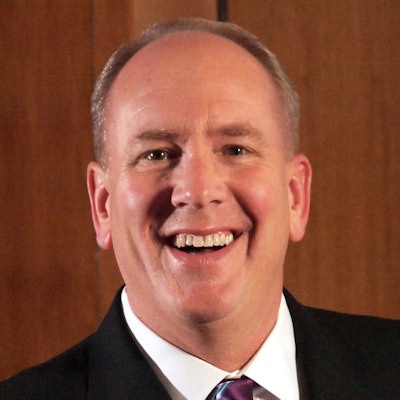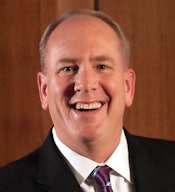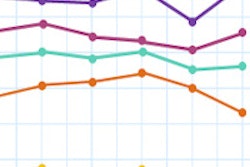
For many businesses, the fourth quarter is the perfect time to assess their performance over the past 12 months and begin planning for the coming year. In addition to profits, losses, and sales projections, it's important to keep in mind that factors related to how businesses pay for capital equipment can also affect their overall financial health.
Forward-thinking business leaders should consider acquiring new or updated equipment before the end of 2016 to take advantage of legislation that both expands deductions and extends depreciation benefits for qualifying equipment purchases. In fact, tax benefits and favorable pricing make the fourth quarter of the year a particularly lucrative time for businesses to finance new or upgraded equipment.
 Mark Hoffman from Key Equipment Finance.
Mark Hoffman from Key Equipment Finance.Financing capital equipment enables businesses to conserve cash and lines of credit while providing maximum flexibility, and entering into a finance agreement at the end of the year is also a smart way for companies to use any remaining capital budget while preparing for the year to come. Consider the factors below when determining whether investing in capital equipment during the fourth quarter of the year aligns with your company's strategic goals.
Section 179
Section 179 of the IRS tax code is an incentive created by the U.S. government to encourage businesses to invest in capital equipment. It covers accelerated write-offs for capital purchases and is particularly beneficial to smaller businesses with limited budgets.
Effective January 1, 2016, businesses purchasing $2 million or less in capital equipment can deduct up to $500,000 of that expense immediately on their 2016 tax return. Financing can further enhance the bottom line by eliminating the upfront cash outlay typical of an equipment purchase while still preserving the Section 179 deduction. However, equipment must be financed and in place by midnight of December 31, 2016, to qualify for the 2016 tax year.
Companies requiring more than $2 million in capital equipment investment in 2016 will need to manage the tax ownership of those additional assets to maintain a Section 179 write-off (there is a dollar-for-dollar phaseout of the deduction for purchases exceeding the $2 million threshold). By using a tax lease for assets exceeding the $2 million threshold, the leasing company becomes the tax owner of the equipment, which allows businesses to maintain the maximum Section 179 deduction on the assets for which they retain tax ownership.
Extended bonus depreciation
Under the same tax legislation adopted by Congress for 2016, businesses of all sizes can depreciate 50% of the cost to acquire eligible equipment on their 2016 tax returns. This tax break has been extended through 2019, although it will phase down to 40% in 2018 and 30% in 2019.
For many businesses, asset depreciation plays an important role in fiscal management. Most equipment acquisitions offer depreciation benefits, but determining whether a company can effectively use all of that depreciation requires some consideration.
This is especially true for equipment-intensive businesses. Full taxpayers in need of the sheltering effect of equipment depreciation will typically benefit from tax ownership of equipment. This can be accomplished with a loan, installment payment agreement, and some leases. All of these options allow the user to deduct depreciation and interest charges from taxable income.
Companies with a more complex tax situation may want to consider a tax lease. Tax leases effectively trade tax depreciation for lower payments. Plus, tax leases allow the entire lease payment to be deducted as an operating expense on the business' tax return. You should consider the following factors when evaluating equipment acquisition options:
-
Alternative minimum tax (AMT). Corporations near to or already paying alternative minimum taxes should be aware of the implications of purchasing assets. These organizations may not be able to effectively use all of the tax benefits associated with accelerated equipment depreciation. Consequently, they can experience an increase in the after-tax cost of acquiring an asset.
In contrast, a tax lease can minimize the creation of additional tax depreciation. The lessor records the equipment ownership and resulting depreciation, and because equipment leasing companies are able to more efficiently utilize the tax benefits associated with depreciation, the lessee can enjoy the savings in the form of lower monthly payments.
-
Net operating losses/tax credits. A tax lease may also be advantageous for corporations with expiring net operating loss (NOL) carryforwards or other similar tax credits. Depreciation deductions on purchased equipment reduce taxable income, sometimes preventing a business from fully using its available tax credits. Leasing allows companies to maximize the use of the credits to lower the tax liability. In this manner, tax benefits are passed on to the customer in the form of lower payments.
-
Midquarter convention. The midquarter convention states that if a company acquires more than 40% of its capital assets during the fourth quarter, it must recalculate its depreciation expense using the midquarter convention tables. Most companies attempt to avoid the midquarter convention by closely managing the number of assets they purchase (and place in service) during the fourth quarter.
Leasing, however, allows a company the freedom to obtain the equipment it needs, when it's needed. With tax leases, companies avoid the fourth-quarter asset acquisition restrictions because the leasing company is the tax owner of the equipment; yet the business still receives the tax benefits in the form of lower payments. Leasing can be a helpful option when project delays or unexpected equipment replacement needs arise in the fourth quarter.
There are many reasons to finance equipment at any time of the year, but companies interested in taking advantage of expanded tax benefits for 2016 and getting a head start on next year should consider financing new or updated equipment before December 31. It may be the best decision you make all year.
Mark Hoffman is senior vice president, healthcare, at equipment financing firm Key Equipment Finance. You can learn more at the firm's website, and he can also be reached at 248-840-2031 or [email protected].



















